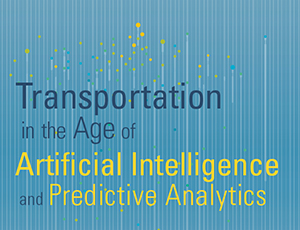Forecasting Freight Transportation Rates with MIT’s Chris Caplice
A car driving on an interstate passes a freight truck. The truck is hauling refrigerators at a rate of $2.93 per mile. Down the highway, the car passes another freight truck, hauling televisions at a rate of $2.88 per mile. That other truck further along, on the horizon? It’s empty, on its way to pick up its next load, and isn’t making a cent right now.
The market for buying freight transportation services, in particular trucking services, is complex and can be challenging to forecast. There are traditional statistical forecasting models, and there are models that use artificial intelligence and can incorporate large amounts of data.
Watch video highlights from Chris Caplice's talk at Volpe. Scroll down to watch his full remarks.
How the Freight Transportation Market Works
Before examining different ways to forecast freight transportation rates, it’s helpful to know how the freight transportation market works, according to MIT Center for Transportation Logistics Executive Director Chris Caplice, PhD, who recently spoke as part of the Volpe Center’s series Transportation in the Age of Artificial Intelligence and Predictive Analytics.
“The thing to remember for truckload operations is that it’s like a taxi cab, as opposed to a bus,” Caplice said. “So, you might pick up a load at Reno, take it to Rapid City, drive empty to Denver, pick up another load, and so forth.”
Shippers purchase truck transportation based on two kinds of rates. Contract rates are rates that are set by contract and are fixed over a period of time. They cover 80 to 95 percent of freight trucking volume. Spot rates come from a secondary market, where shippers bid for one-off deals, typically at higher rates than by contract. The spot market covers 5 to 20 percent of volume.
“Contract rates are very different from spot rates, and that is what causes the problem in transportation, in trying to forecast,” Caplice said.
Spot rates are binding. The carrier accepts the load and goes right away. Contract rates, however, are non-binding. Carriers refuse between 5 and 10 percent of loads under contract, Caplice said.
“So what am I going to predict?” Caplice said. “Do I predict the average rate? Do I predict the median? Do I predict the range? This is the challenge. There is more going on than just a single market rate, and this is why there is variability in contract rates.”
Using Artificial Intelligence to Develop Market Predictions
Time series prediction is the most popular technique to estimate product demand, Caplice said. With the time series method, the average of the last eight weeks is taken to forecast the next week.
Exponential smoothing is another method that uses past data to predict demand, and also incorporates patterns to identify trends. Another slightly more sophisticated method takes into account that an event from two weeks ago may have a different effect on a prediction than an event from a month ago.
“The problem is that these are good for an individual lane,” Caplice said. “A shipper can have thousands of lanes. So running a time series for each lane is time consuming, and I don’t know anyone who does it.”
Regression analysis, which correlates a host of factors to shipping costs, is useful for long-term prediction, Caplice said. Artificial neural networks, which are loosely based on the structure of neural networks in the human brain, may be useful for predicting short-term shipping rates.
“I had a student, she went and looked at this, trying to predict the next seven days on a lane and do a rolling forecast,” Caplice said. “And we’re trying to figure out, should I do one big forecast for the previous year and then predict seven days? Should I have a rolling, where it takes the last seven to predict the next seven? Do I do the last three weeks to predict the next seven?”
Those questions are still open, but initial findings showed that neural networks had comparable predictive power to sophisticated time series analysis, Caplice said.
Data Mining and Other New Directions
The Center for Transportation Logistics is exploring several other areas related to how freight transportation markets are structured, Caplice said. One is the possibility of index-based rates, where rates adjust based on market trend benchmarks. Another is guaranteed contracts, where the carrier provides a lower rate but gets paid whether or not they deliver a particular load.
Electronic logging devices with real-time location data on drivers and loads have downsides but also strong upsides, Caplice said, and shippers are interested in how they can mine that data. And, there is the potential to bring ridesharing concepts to freight movement, with more loads sold on the spot than the contract market.
“It’s interesting to see what’s going to happen,” Caplice said. “Will a larger percentage of truckloads move to spot instead of contract if you can ride that market and make it more reliable?”
Watch Chris Caplice's full remarks from his talk at the U.S. DOT Volpe Center as part of our 2018 speaker series, Transportation in the Age of Artificial Intelligence and Predictive Analytics.

